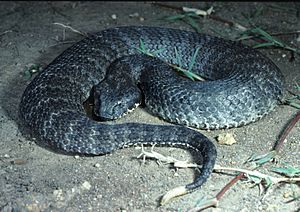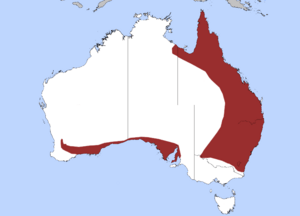Common death adder facts for kids
Quick facts for kids Common death adder |
|
|---|---|
 |
|
| Conservation status | |
| Scientific classification | |
| Genus: |
Acanthophis
|
| Species: |
antarcticus
|
 |
|
| Distribution of the common death adder in Australia | |
| Synonyms | |
|
List
Boa antarctica Shaw & Nodder, 1802
Acanthophis cerastinus Daudin, 1803 Acanthophis brownii Leach, 1814 Ophryas acantophis Merrem, 1820 Vipera sorda Salvado 1851 Boa aculeata Boulenger 1896 |
|
The common death adder (Acanthophis antarcticus) is a type of snake found in Australia. It's known for being one of the most venomous land snakes in Australia and around the world. Even though it's still found in many places, it's facing a growing danger from the cane toads that have invaded Australia.
Contents
About the Common Death Adder
The common death adder was first described in 1802. A scientist named George Shaw gave it the name Boa antarctica. Later, in 1803, another scientist, François Marie Daudin, created a new group for it called Acanthophis.
What Does It Look Like?
The common death adder has a wide, flat, triangle-shaped head. Its body is thick and has bands of red, brown, and black colors. Its belly can be grey, cream, or pink.
These snakes can grow to be about 70 to 100 centimeters (around 2 to 3 feet) long. They have the longest fangs of any snake in Australia! The common death adder belongs to the snake family called Elapidae. This is different from the Viperidae family, which includes snakes like the European adder. There are no Viperidae snakes in Australia.
Where Do They Live?
Common death adders live in many parts of eastern and coastal southern Australia. You can find them in Queensland, New South Wales, Victoria, and South Australia. They are less common in the Northern Territory and Western Australia. They also live in Papua.
These snakes like to live in forests, woodlands, grasslands, and heathlands along Australia's eastern coast. They are very good at hiding! Their striped patterns help them blend in with leaves and other things on the ground.
Threats to Death Adders
Two main problems threaten common death adders. One is the loss of their natural homes. The other is the spread of invasive cane toads in Australia. Young death adders can be eaten by the toads. Also, adult death adders that eat the toads get poisoned by their skin. This poison is very dangerous to Australian reptiles and can kill the snakes.
What Do They Eat?
Common death adders mostly eat small mammals and birds. Unlike many other snakes, they don't chase their food. Instead, they wait patiently for prey to come by, sometimes for many days!
They hide themselves under leaves, making it hard to see them. They coil up and twitch their tail, which looks like a small worm. This tricks other animals into coming closer to investigate. When an animal gets close enough, the death adder strikes very quickly. It injects its venom, then waits for the animal to die before eating it.
Death adders are not usually aggressive towards humans. However, because they hide and wait for prey, they can be more dangerous to people who walk through their habitats without seeing them.
Common Death Adder Reproduction and Life Cycle
Most snakes lay eggs, but the common death adder is different! Female death adders give birth to live young. This usually happens in the late summer. A mother death adder can have a litter of about 3 to 20 babies at once. Sometimes, even more have been seen, with over 30 young in a single birth! These baby snakes are born ready to survive on their own.
About Their Venom
The common death adder's venom is very strong. It contains a powerful substance called a neurotoxin. This neurotoxin can cause paralysis, which means the body can't move, and it can even lead to death.
These snakes can strike faster than any other venomous snake in Australia. If a person is bitten, serious problems can happen within six hours.
See also
 In Spanish: Víbora de muerte común para niños
In Spanish: Víbora de muerte común para niños


